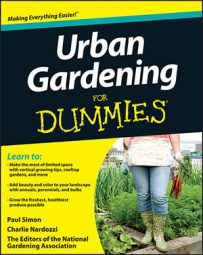Most people think of farms as beautiful places in pastoral settings. Even in botanical gardens that grace most cities around the globe, the greenery and gardens there create a sanctuary that is fenced in and often hidden from view.
But cities have many places to garden beyond the botanical garden. Many city residents have a yard where they can tuck in gardens. In some communities, rules may be in place restricting where on your property you can garden and what you can plant.
City residents in many areas are challenging the notion they can’t grow food gardens in their own front yard. Pulling up the traditional lawn and planting tomatoes, zinnias, and apples is just one way urbanities are gardening in the city. Here are some other obvious and not so obvious ways they also are growing greenery amidst the concrete and steel.
Vacant lots. Many cities are taking vacant lots and transforming them into small parks, green oases, and community gardens. These “community” gardens often take on the flavor of the residents and become meeting places for the neighborhood. Often the garden is a harbinger of change in the neighborhood.
Once a garden springs up in a vacant lot, trash and litter may be picked up, graffiti replaced with murals, and decorative art work installed in the neighborhood. All this creates an identity reflecting the various cultural and ethnic backgrounds of the residents in the neighborhood.
Grow it in a pot. Container gardening has revolutionized the ways people can grow plants in small spaces. Container growing helps avoid many soil issues because you are using soil specifically adapted to pot growing. Plus, if you don’t have the space or proper conditions in the ground where you live, it’s pots to the rescue.
Containers not only fit in unusual places, like fire escapes, but they are mobile and can be moved with the sun and season.
Growing on the roof. Rooftop gardens can produce food for a hungry city, reduce the urban Heat Island Effect, and reduce storm water runoff. If the roof won’t work, try the walls. Green wall gardens are springing up in many cities that not only have many of the same benefits as green roofs, but also visually soften the look and feel of a city block.
Trellises, pergolas, fences, and arbors are all ways to make use of the vertical space gardeners may have in their otherwise space-limited yard. Growing vines upward is a way to maximize what you have growing in the city.
Inside gardening. Some folks have only a balcony or patio or live many stories up. The solution for these land-deprived residents is apartment gardens. Using grow lights and maximizing the light through windows, you can grow houseplants that clean your air and edible plants to provide food. Windowsill herb gardens and salad gardens under lights are just some of the ways apartment dwellers can jump on the green bandwagon.

